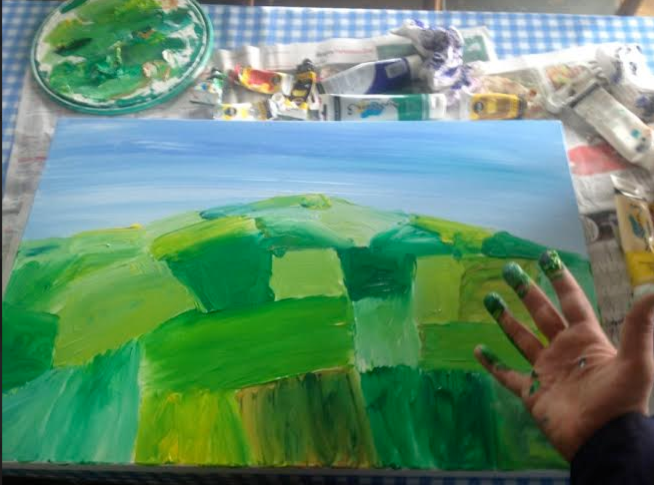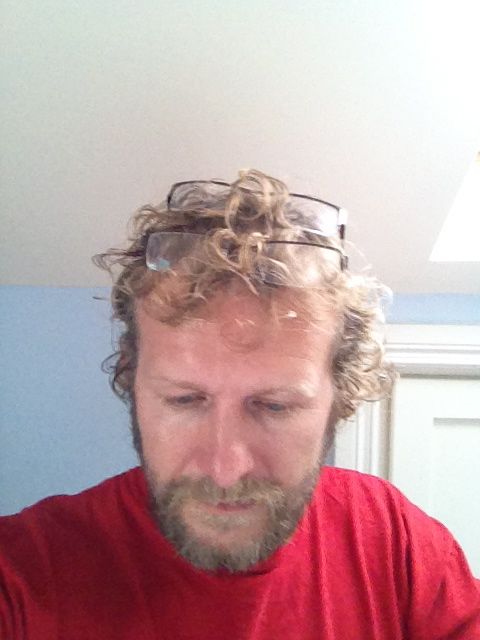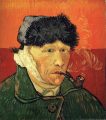
Being An Artist
Please Give Us A Few Words Of Introduction About Yourself
I am a folk artist (specifically a new wave wang-eyed pop folk artist) tapping a well of inspiration — hidden landscapes, sad skies, old maps, memories, politics, old films and old love letters. Like a young butterfly stuck in a Doctor Who-style time loop, I am constantly emerging, but in slow motion. I play out my subconscious desires, loves and obsessions in my art and relish the freedom to make art that is intensely personal. As well as painting pictures with lots of words on them. I also write books with lots of pictures.
When Did You Decide To Pursue Art As A Career?
In terms of career stuff I have tended to just find things I enjoy doing and follow them — then develop it in such a way that it can become part of my multi-faceted (or fragmented, depending on your point of view) work life. When I was a kid I read about Picasso and somehow felt that I wanted that kind of creative life. At ‘A Levels’ I got a disappointing grade and gave up my art for a year or two… but it’s something I couldn’t ignore and though I went down the writing route, art showed up in my life in the guise of illustration opportunities (I’ve worked as a graphic artist for the football magazine When Saturday Comes for 25 years). Then a decade ago I moved with my family to the West of Ireland for a while — there, the combination of time, a good studio, light, subject matter, big skies, like-minded people and Ley line intersections enabled me to start properly thinking of myself as An Artist for the first time.
What Training Did You Have?
I haven’t had any formal training — not beyond school, anyway. That probably puts me in the ‘naïve painting’ bracket. I am naïve, though not necessarily in my art. At school I had a great art teacher, Robin Conybeare. My grandfather was a part time sketcher and sculptor. My dad is also a gifted artist but kept it under wraps until he retired… possibly he communicated his ideas telepathically or through the smoke from his many backfield bonfires. Later on I did various art evening classes when I first came to London — life drawing and sculptures of Margaret Thatcher as envisioned by Francois Mitterand — but never went to art college.
What Has Been The High Point Of Your Career So Far?
My first solo show Bachelors Walk — Scenes from a North Clare Townland at the Courthouse Gallery in Ennistymon — where I was able to exhibit my work to all kinds of people who wouldn’t normally go into a gallery. I felt that I’d managed to successfully recreate the vision I had in my head and realized that people liked what I was doing. And my most recent solo exhibition from a couple of years ago, New Wave Wang-Eyed Pop Folk Art – A Retrospective. It was like seeing my brain uploaded into a big room.

General Questions
What’s Your Favourite Quote?
There are lots of amazing quotes about the artistic process. They’re always slightly out of context, I suppose, but for now I’m going to pick one that appeared on Twitter a couple of years ago from the writer Joyce Carol Oates.
“The secret of art, for the artist, is this yearning for something inexpressible that doesn’t yet exist–the artist must create it.”
Who Is Your Favourite Artist?
Don’t really have a favourite, though have loved at various times Egon Schiele, Mark Rothko, Frida Kahlo, Jack B Yeats, Jean Michel Basquiat, Terry Gilliam, Pauline Boty. Currently I like Grayson Perry’s maps and my friend Sara Foust’s melancholy landscape scenes. And whoever did all those ace African barbershop signs.
What Are Your Artistic Goals?
To have more regular themed solo exhibitions. More generally, to continue producing work that might be about something mundane while also attempting to express what it is to be alive. To keep uploading snapshots from of my brain onto canvas.
How Will You Get There?
Continue to both focus and keep my mind open to what’s around me. Get a bigger studio. And stop procrastinating (see next question).
Is Anything Holding You Back?
The usual things…Time. Self-doubt. Being brought up in Lincolnshire. I am quite reserved and this has possibly stopped me doing certain things over the years — the comfortable inertia of the thwarted idealist, perhaps. I spent much of my twenties in a slightly diffused state — travelling around, writing unpublishable novels, songwriting, being a sports cartoonist for The Observer, attempting to become a druid, doing film reviews, jacking in jobs, living in South America. Now I’m more disciplined in terms of getting work done, though I still rely on that procrastinating spirit, that I used to be, to come up with ideas.
You and Art
What Feelings Or Reactions Do You Hope To Arouse In People Who View Your
Work? Are You Ever Surprised By Reactions That You Get?
The vivid, mostly primary, colours are intended to have a life-affirming effect on the viewer, perhaps with the sense of having a revelatory vision, a mild migraine or recovering from a hangover. I like to think of my art as spiritual in some way… though to be more accurate I like the idea of getting people to subtly question things.
Certain paintings seem very popular but I can never work out why that is — sometimes there’ll be several people all trying to buy the same one.
From Start To Finish, How Long Does It Take For You To Create Your Work?
How long is the road to the sea? I can finish something in less than an hour. Other paintings have taken over a decade to finish. But looking at them you wouldn’t be able to tell which was which.
What Music Do You Like To Listen To When You Work?
As a teenager it was usually A Certain Ration’s Sextet LP. Nowadays, although I need silence when I’m trying to plan a piece of work, once I’m in the flow I listen to a range of music to keep me into a relaxed alpha-ish brainwave state… ambient electronica, bluegrass, country, folk, Gregorian chant, Irish traditional music (especially Planxty). Specific example songs: ‘Alone’ by Trampled by Turtles, ‘Tear Stained Eye’ by Son Volt, ‘Reach for the Sun’ by The Polyphonic Spree, ‘Do you Realise?’ and ‘Summertime’ by The Flaming Lips.
What Are You Working On Next? Any Future Plans Or Projects In The Pipeline
That We Should Look Out For?
I have several exhibitions that I’m working towards, slowly. A series of icon style paintings of some of my heroes. And more work inspired by my childhood in the 1970s. Plus lots more nature based art — botanic transcendental paintings! And hopefully, one day, an exhibition of my reconstituted charity shop art. In a charity shop.
Being Inspired By Art
Who (Living Or Dead) Inspires You? And Why?
Lots of people, but here’s one… My grandfather, Frank Sowden. I have one of his sculptures on my desk. He never finished it — was working on it when he died — and it’s a reminder to me that eventually we have to let go of work, that we can never do everything we want. Frank worked in a woolen mill in West Yorkshire all his life. In his spare time, and after he retired, he pursued his interest in art. Drawing and sculpture, mainly. Educated himself, really. The feeling I always got from him was a positive view of humanity and the endless possibilities of art.
What Feelings, Subjects Or Concepts Inspire You As An Artist?
In my twenties I lived for a while in Venezuela and was heavily influenced by rural folk art. Other influences include Egyptian funerary portraits, Holy well decorations, African barbershop signs, religious icons, surf T-shirts, old football cards, crap signs, those blue photos you get in old shop windows. In the West of Ireland I rediscovered my love of folk art as a way of communicating ideas. A lot of my work involves fruitless searches for things that are lost, be they people, underground rivers, stories, buildings or ways of life. Regular motifs include the connecting and merging of maps, old photographs and whiskey-based visions. The beauty of the mundane. And a way of communicating love.
What Is Your Favourite Work That You’ve Produced So Far And Why?
Probably Mountain Girl. A couple of years ago, while we were on holiday in Ireland, I heard this mesmerising old time song on the radio — a woman singing plaintively over what sounded like a dulcimer drone backing — and strained to hear who it was by. I discovered the artist was Jean Ritchie and did a bit of research on her. She died just a few weeks ago, in her 90’s. Jean was brought up in the mountains of Eastern Kentucky and, because there was no radio out there, her family would sing their old songs and tell stories, many old ballads brought from Britain by her ancestors. Jean became a dulcimer player — the Appalachian lap version (not the banjo-ey thing that I bought off the internet from some hippy website in California ten or more years ago).
My source for the painting was a famous black and white photo of the young Jean playing her dulcimer. However, for some reason I also appear to be channeling the actress Kate Beckinsale. Don’t know what’s going on there. The picture is done in what I think of as high folk-art style — so any subtle use of colour is purely unintentional. (One of my best friends has Mountain Girl on her wall so I can see her whenever I want).
Another of my favourite works is I Know A Path Where The Cow Parsley Grows. This is cow parsley that I found on Parkland Walk, the track along the old railway line from Finsbury Park to Highgate. Although it’s slightly cack-handed flower painting I also like to think that in some way it is a portrait.
An Artist’s Advice
For Those Thinking About Turning A Passion For Art Into A Career, Could
You Give Any Advice?
1. Tap into everything that inspires and interests you
2. When you find a style that is right for you stick with it and develop it.
3. Put the hours in… paint even when you don’t feel like it.
4. Learn to communicate about your art. Ultimately it is the work itself that should speak but it does help if you can guide people and explain your process. Work on writing about your art and motivations as well.
5. Get organized about selling and marketing your stuff. (I find it really hard.)
6. Probably you shouldn’t take advice from the likes of me.
Any Tips On How To Get Your Work Seen And Get The Commissions Coming In?
Not really… other than that I think organizing an exhibition is a great way to get more people to see your stuff and lets you meet people in a relaxed environment where you can talk about your art. To start with get a group of like-minded artists and source a good venue.
————
Check out more of Tim’s work at www.timbradfordart.co.uk/











